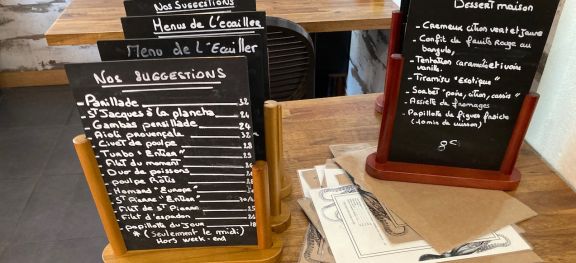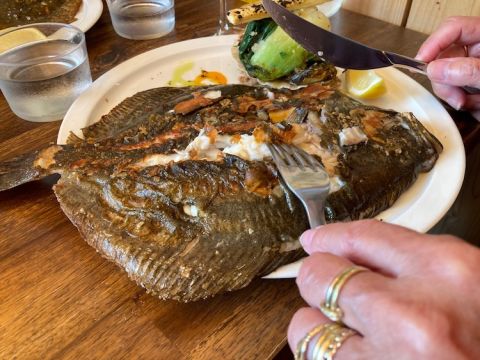What has become of the menu?

Two Languedoc restaurants reviewed as we leave the region for Burgundy en route home to London.
Despite their many charms (in my view), time and events have not been kind to either of my books, The Art of The Restaurateur (Phaidon 2012) and On The Menu (Unbound 2016).
While the passage of time could have heralded a second version of my book on restaurateurs with perhaps younger additions to those 20 I initially portrayed, it is events that have so significantly overtaken my second book. And, in particular, it has been COVID-19 and its potential threat to our well-being from too many different people handling the same pieces of paper that have stifled the inventive design of menus.
Restaurateurs have responded in different ways. Many have chosen QR codes to allow guests to open the menu and the wine list on their phones. Others have reprinted their menu and wine list themselves, invariably in black and white, and made a policy of destroying these pieces of paper after each service. It may well be that On The Menu will stand the test of time as a record of a bygone era rather than its supposed aim of inspiring restaurateurs, chefs and their designers to greater things.
Two French restaurants recently demonstrated to me their various interpretations of menu design in our pandemic-restricted times. The effects were perhaps less romantic than before but each was extremely safe in its own way.
The first was the paper version of the menu at Le Moulin de Trèbes just outside the town of Trèbes, itself a 15-minute drive east of Carcassonne, and right by the first lock on the Canal du Midi that those who have picked up their boat in Trèbes’ little port need to negotiate before heading off towards Narbonne (and presumably why a table here is such a great spot for witnessing spats between couples). The sound of the water rushing through the lock and the view of the sunset to the west are two other, perhaps more natural, reasons for choosing to eat here.
As is the idea of giving moral support to Pascal and Sophie Ledroit, the couple who for the past several years have run Le Moulin, during a period when perhaps events could have overwhelmed a less redoubtable pair. Firstly, there was the terrible shooting at the supermarket a mile away which left four dead; then there was the flooding of the river Aude in which several Trèbes inhabitants lost their lives and considerable damage was wrought; and finally, along came COVID-19, with its consequent restrictions. Perhaps it is because they are from outside the region – he is Belgian, she is Belgian/Greek – that they have decided to stick here so resolutely. Or perhaps they just revel in the lovely afternoons and evenings when there can be few more beautiful spots.
On the night we had booked, to find the menu and the wine list printed and ready for us on our table, it was beginning to drizzle outside and watching customers walk in under umbrellas, or going out to their cars for an extra layer of clothing, proved a novelty for us. It took us only seconds to decide what to eat but first we had to be put in our place. A young, charming waiter approached and asked us whether we were ready to order an aperitif. ‘No, but we are ready to order our food’, we replied. ‘That’, came the response, ‘is not my responsibility.’ We had to wait for Madame.
But regardless of the weather, an appetite is all you really need to enjoy the cooking of Ledroit, a chef who does not believe in any customer leaving his restaurant hungry. Among the first courses are a warm escalope of foie gras with a chocolate sauce; another variation of foie gras, mi-cuit, with a particularly well-judged chutney; and five delicious, plump oysters from Bouzigues, poached with bacon, horseradish and Noilly Prat (when was the last time this was on a menu, I wondered, as I very much enjoyed this dish).
Then, as so often, Jancis chose a second first course, caramelised veal sweetbreads with endives and sesame, while for me came a piece of roast veal with Jerusalem artichokes and lemon. We shared a glass of Demeter-certified Pinot Noir from the enterprising Domaine Ste-Marie des Crozes and a couple of glasses of 2019 Minervois from Château Canet, which is even closer to the restaurant, to generate a bill of €111.
And while Jancis’s dessert of a croustillant of raspberries was excellent, with mine, described as an apricot crumble with vanilla cream and brown sugar, Ledroit fell into the common error of French chefs of believing that a crumble simply has to have a topping of some sort of biscuit to earn this description. But his cold rendition of otherwise well-cooked apricots, cream and biscuit does not a crumble make – especially on a cold evening! A crumble has to be cooked, regardless of whether it is then served hot or cold: if not, the word crumble should carry inverted commas on the menu. Rant over.
In Narbonne, at L’Écailler Gourmet, a restaurant just behind the city’s Palais de Justice or courthouse, they do things slightly differently but very much in keeping with the piscatorial theme of its kitchen. In fact, the restaurant doubles as a place to eat on one side and on the other a shop/traiteur from which one can buy anything from lobster to Irish crabs to anchovies. Both sides join at the back in which the kitchen is located.
An important side table houses all the menus when they are not in use. These number about a dozen and each incorporates a small blackboard that lists first of all the restaurant’s menu, another which lists all the specials of the day, and a third that lists all their desserts.
This I almost missed because of the generosity of our host who claimed that he would pre-order for us: a wild turbot for three of us, their last John Dory for me. When these arrived we were extremely pleased with his intervention. They were perfectly grilled with an accurate sprinkling of herbs and here, unlike the common practice in Spain, they were served with a precisely judged selection of vegetables. The fish soon became a bowlful of cleanly picked bones.
With this we drank a bottle of Les Ollieux Romanis 2020 Blanc Cuvée Classique. A dessert described simply as a ‘cremeux of limes and lemons’ from the blackboard menu of seven different desserts all headed ‘home made’ was another hit, the slightly acidic lemon offset by a crumbled thick biscuit (but no pretence as this being a crumble!). This was followed by a very reasonable bill of €181 for the four of us.
I fear the impact of COVID on how restaurateurs choose to present their menus may be long term. Certainly, the practice of a maître d’ hovering over your table clutching carefully designed menus and wine lists may be gone for a long while. But in the interim, restaurateurs can choose to be inventive. At L’Écailler Gourmet a series of different blackboards, not handled by the customers, unquestionably projects the appropriate atmosphere of a friendly, fish-focused bistro.
Le Moulin de Trèbes 2 rue du Moulin, 11800 Trèbes; tel: +33 (0)4 68 78 97 57
L’Écailler Gourmet 15 rue d’Isly, 11100 Narbonne; tel: +33 (0)4 68 90 13 55
Become a member to view this article and thousands more!
- 15,411 featured articles
- 274,607 wine reviews
- Maps from The World Atlas of Wine, 8th edition (RRP £50)
- The Oxford Companion to Wine, 5th edition (RRP £50)
- Members’ forum
- 15,411 featured articles
- 274,607 wine reviews
- Maps from The World Atlas of Wine, 8th edition (RRP £50)
- The Oxford Companion to Wine, 5th edition (RRP £50)
- Members’ forum
- Commercial use of our Tasting Notes



